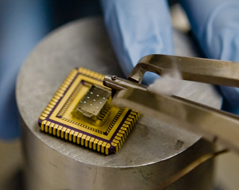HP's inkjet tech to deliver drugs

A Singapore-developed technology used in Hewlett-Packard's patented process for its inkjet cartridges, could soon be used in skin patches to administer drugs.
 Crospon's prototype transdermal patch |
The locally-developed microneedle technology is used in Hewlett-Packard's patented process for its inkjet cartridges, could soon be used in transdermal patches to deliver time-controlled release of drugs to patients.
HP announced Tuesday that it will license its microneedle technology to Crospon, an Ireland-based medical device maker, to develop and manufacture drug-laden skin patches for the healthcare market.
In a phone interview with ZDNet Asia, Crospon CEO John O'Dea said that the skin patch is akin to "a very small infusion pump". Still at the prototype stage, the patch will likely be 25 mm square in size and 3 mm thick. It will incorporate an array of microneedles that are between 75 and 100 microns, which will penetrate the top dry layer of the skin, also known as the stratum corneum.
"Above the microneedles is an array of wells, [and] those wells can hold one or a number of drugs," O'Dea explained, adding that for the actuation of drugs, the device has "an active mechanism to push the drug through the needle".
As such, the patient is not depending on a "passive" type of drug delivery, he said.
According to O'Dea, the device will be completed and ready to hit the market in three to four years' time. By then, it will also have a CPU onboard, likely to be in the form of "a regular micro controller type system" on flash memory, and be programmable to deliver one or multiple drugs at an appropriate dosage and time.
For instance, a patient after a cardiac surgery would be on as many as up to eight different drugs, all of which could be contained in one device--the transdermal patch.
From printers to patients
Lim Eng Hann, associate director of HP's Asia-Pacific IP Licensing Center, told ZDNet Asia in the same phone interview that the technology used for the drug delivery system is not an exact replica of HP's inkjet technology, but a modified version.
"The programmable part [of the patch] comes from HP's inkjet technology where we could program to fire different nozzles for ink, and we repurposed that for firing drugs," Lim said.
Two components are involved in the technology transfer from HP to Crospon: the microneedles which dispel the drug, and the "firing" mechanism that excretes the drug.
"We believe it's an industry first to be able to deliver multiple drugs through a single patch with microneedles," O'Dea said.
He acknowledged that while there are also players in the market "exploiting the potentials of microneedles", there is no skin patch incorporating microneedle technology that is on sale in the market today.
ZDNet Asia understands that companies such as Procter & Gamble, Debiotech and Exploit Technologies--the commercialization arm for Singapore's Agency for Science, Technology, and Research (A*STAR)--have also used microneedle technology for transdermal drug delivery systems.